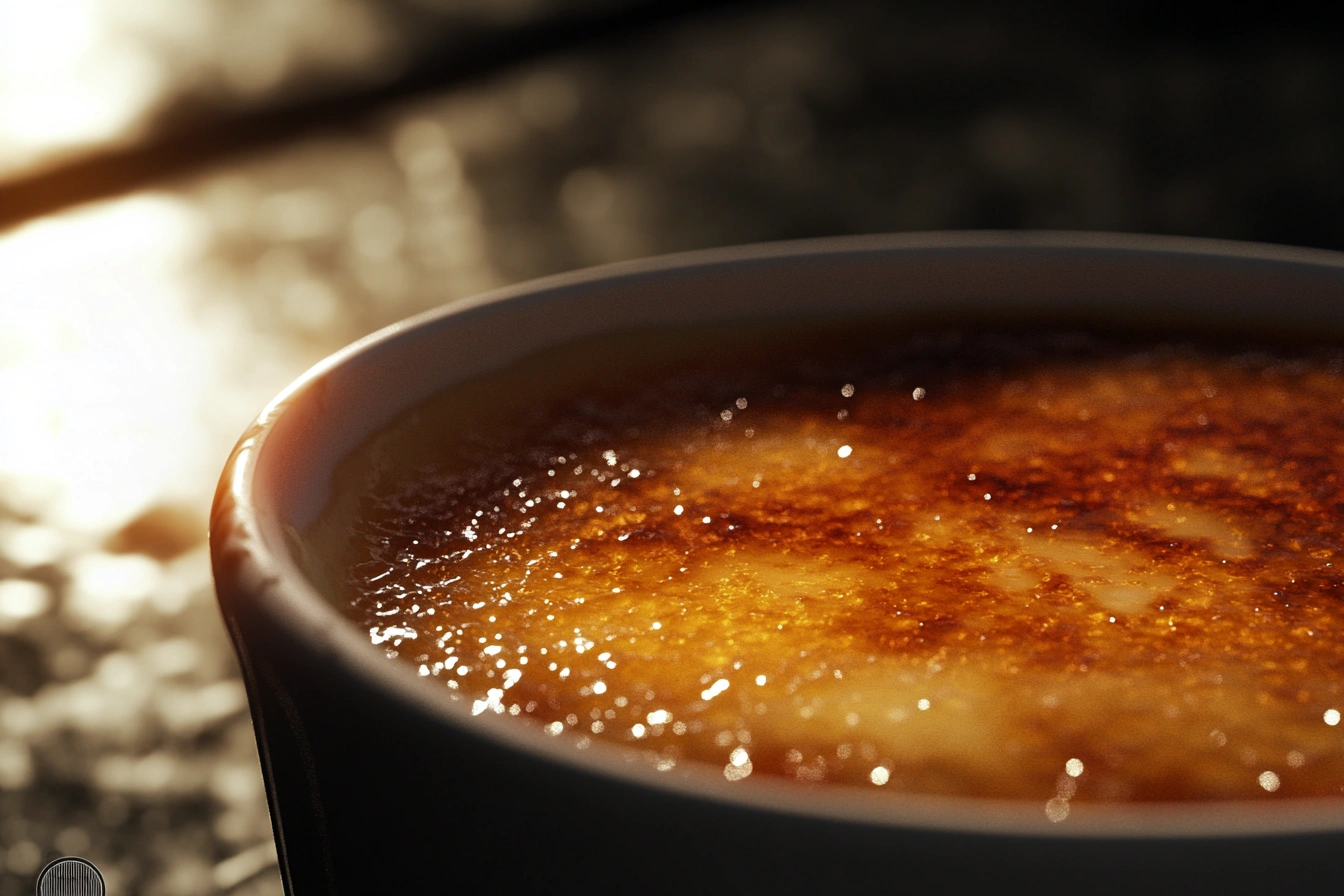Understanding Overcooked Crème Brûlée
1. Introduction: Can You Overcook Crème Brûlée? (200 Words)
Crème brûlée is one of the most delicate and elegant French desserts, known for its silky smooth custard base and crisp caramelized sugar topping. While it seems simple, achieving the perfect texture and consistency requires precision and careful temperature control.
One of the most common mistakes when making crème brûlée is overcooking the custard. Unlike other desserts that can tolerate slight overbaking, crème brûlée is extremely sensitive to heat. Overcooking causes the custard to curdle, crack, or become rubbery, ruining its luxurious mouthfeel.
The key to perfect crème brûlée lies in slow, even cooking at the right temperature. The custard should be firm but still creamy, with a slight jiggle in the center when removed from the oven. Overcooked crème brûlée, however, can develop a grainy texture, eggy flavor, or even unsightly cracks on the surface.
So, can you overcook crème brûlée? Yes, absolutely. But with proper techniques, temperature control, and baking methods, you can avoid this mistake and achieve a smooth, decadent custard every time. In this guide, we’ll explore what happens when crème brûlée is overcooked, how to prevent it, and the best ways to ensure perfect results.
Table of Contents
2. What Happens When You Overcook Crème Brûlée? (250 Words)
Changes in Texture
Overcooked crème brûlée loses its signature silky consistency and becomes:
- Rubbery – Overbaking causes the custard to set too firmly, creating a dense, stiff texture instead of a delicate, melt-in-your-mouth feel.
- Grainy – Excess heat can curdle the eggs, causing the custard to separate into a lumpy texture rather than remaining smooth.
- Cracked – If left in the oven too long, the custard can dry out and form cracks on the surface.
Flavor Impact
- Properly cooked crème brûlée has a delicate, creamy vanilla flavor.
- Overcooked crème brûlée can develop a scrambled egg taste due to excessive heat cooking the eggs too quickly.
- The balance between sweetness and richness is lost when the custard is overcooked.
Visual Signs of Overcooking
- Bubbles on the surface – Indicates that the custard was cooked at too high a temperature or for too long.
- Deep cracks – Suggests the custard has lost moisture and overbaked.
- Darkened edges – The edges should be set but not browned; browning indicates overcooking.
Recognizing these signs early can help prevent overcooking and preserve the integrity of your crème brûlée.
3. Ideal Baking Temperature & Time (300 Words)
Best Temperature Range for Baking Crème Brûlée
To achieve the perfect creamy texture, crème brûlée should be baked low and slow. The ideal baking temperature is:
- 275–300°F (135–150°C).
- Higher temperatures (above 325°F/160°C) can cause the eggs to curdle, resulting in a grainy or rubbery custard.
How Long to Bake Crème Brûlée
The baking time varies depending on:
- Oven type (conventional vs. convection).
- Size of ramekins (smaller ramekins bake faster than larger ones).
- Depth of custard (shallow ramekins cook more quickly).
General Baking Guidelines:
- Small ramekins (4 oz / 120 ml): 25–30 minutes.
- Medium ramekins (6 oz / 180 ml): 30–35 minutes.
- Large ramekins (8 oz / 240 ml): 35–40 minutes.
Water Bath (Bain-Marie) Method: Preventing Overcooking
A water bath is essential for maintaining gentle, even cooking and preventing the custard from overcooking.
Steps for a Proper Bain-Marie:
- Place the ramekins in a deep baking dish.
- Pour hot water into the dish until it reaches halfway up the sides of the ramekins.
- Bake at low temperature to prevent direct heat exposure.
- Cover the baking dish lightly with foil to regulate the heat.
How to Check for Doneness
The perfectly baked crème brûlée should:
- Be set around the edges but still jiggly in the center when gently shaken.
- Reach an internal temperature of 170°F (76°C) – use a thermometer for accuracy.
- Firm up as it cools; do not wait for it to set completely in the oven.

Preventing & Fixing Overcooked Crème Brûlée
4. How to Prevent Overcooking (250 Words)
Crème brûlée is a delicate custard, and overcooking ruins its silky texture. To prevent this, follow these key techniques:
1. Use a Water Bath (Bain-Marie)
- A water bath helps regulate heat, ensuring gentle, even cooking.
- Without it, the direct heat from the oven can cause the custard to overheat and curdle.
- Fill the baking dish halfway with hot water so the ramekins bake slowly and evenly.
2. Monitor the Internal Temperature
- Crème brûlée should never exceed 170°F (76°C).
- Use a kitchen thermometer to check the temperature before removing it from the oven.
- If it goes over 180°F (82°C), the eggs will scramble, creating a grainy texture.
3. Avoid Overbaking
- The custard should be set around the edges but still jiggly in the center when removed from the oven.
- It continues to set as it cools, so taking it out too late leads to a rubbery texture.
- If the custard is firm all over before cooling, it’s already overcooked.
By following these precise temperature and timing controls, you can achieve a perfectly smooth, creamy crème brûlée every time.
5. Fixing Overcooked Crème Brûlée (200 Words)
Overcooked crème brûlée may not be ideal, but it’s still salvageable! Here’s how to fix common issues:
1. If It’s Grainy:
- Blend the custard in a food processor or blender for a few seconds.
- This breaks up the curdled egg proteins, resulting in a smoother texture.
- Re-chill before serving.
2. If It’s Rubbery:
- Instead of torching the top, serve it as a chilled custard dessert.
- Pair it with fruit compote or whipped cream to balance the texture.
- Next time, reduce the baking time or temperature.
3. If It Has Cracks:
- Cover the cracks with extra caramelized sugar, fresh berries, or chocolate shavings.
- Cracks don’t affect the taste but indicate overbaking.
While you can’t completely reverse overcooking, these methods help improve the texture and make the dessert still enjoyable.
6. Common Mistakes & How to Avoid Them (250 Words)
1. Baking at Too High a Temperature
❌ Issue: Cooking at above 325°F (160°C) causes eggs to curdle.
✅ Solution:
- Always bake at 275–300°F (135–150°C) for slow, even cooking.
- Check for doneness early to avoid overbaking.
2. Skipping the Water Bath (Bain-Marie)
❌ Issue: Direct heat exposure leads to uneven cooking and a rubbery texture.
✅ Solution:
- Always use a hot water bath to insulate the custard from direct heat.
- Ensure the water reaches halfway up the ramekins for best results.
3. Over-Torching the Sugar Topping
❌ Issue: Applying too much heat burns the sugar and overheats the custard.
✅ Solution:
- Hold the torch 6 inches away, moving in circular motions for even caramelization.
- Torch in layers to prevent excess heat transfer to the custard.
Avoiding these common pitfalls ensures a flawless, creamy crème brûlée every time.

7. Frequently Asked Questions (FAQs) (300 Words)
1. Can crème brûlée be too firm?
Yes! Overbaking makes it rubbery and stiff. The custard should be smooth and creamy, not solid.
2. How do I know if my crème brûlée is overcooked?
Signs of overcooking include:
- Cracks on the surface.
- Bubbles forming on top.
- Grainy or scrambled egg texture instead of smooth creaminess.
3. Can I save an overcooked crème brûlée?
Yes! You can:
- Blend it to improve texture.
- Serve it as chilled custard if it’s rubbery.
- Mask cracks with fruit or caramelized sugar.
4. Why does my crème brûlée taste like eggs?
This happens when the custard is cooked at too high a temperature, causing the eggs to overcook.
- Next time, bake at a lower temperature and use a water bath.
5. What is the best way to get a perfect texture?
Follow these golden rules:
- Use a water bath for gentle cooking.
- Bake at 275–300°F (135–150°C).
- Remove from the oven when slightly jiggly in the center.
- Chill for at least 4 hours before serving.
By mastering these techniques, you can create flawless, restaurant-quality crème brûlée every time! 🍮🔥
Conclusion
Crème brûlée is a delicate and luxurious dessert, but it requires precise baking techniques to achieve the perfect silky texture. Overcooking is one of the most common mistakes, leading to a rubbery, grainy, or cracked custard. By understanding the ideal temperature, baking time, and the importance of a water bath, you can prevent these issues and create a smooth, creamy dessert every time.
If you accidentally overcook crème brûlée, don’t worry—there are ways to fix or repurpose it. Blending the custard, serving it chilled, or masking cracks with caramelized sugar can salvage an imperfect batch. However, the best approach is always prevention. Watching for visual signs of doneness, using a low and slow baking method, and removing it from the oven at the right time will help you master this classic French dessert.
By following the techniques and troubleshooting tips outlined in this guide, you can confidently prepare crème brûlée that is rich, smooth, and flawlessly caramelized—just like a professional pastry chef! 🍮🔥

